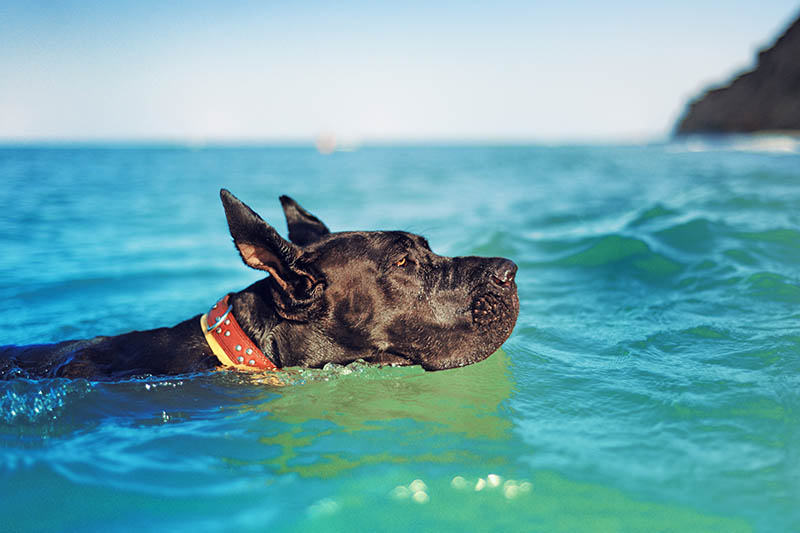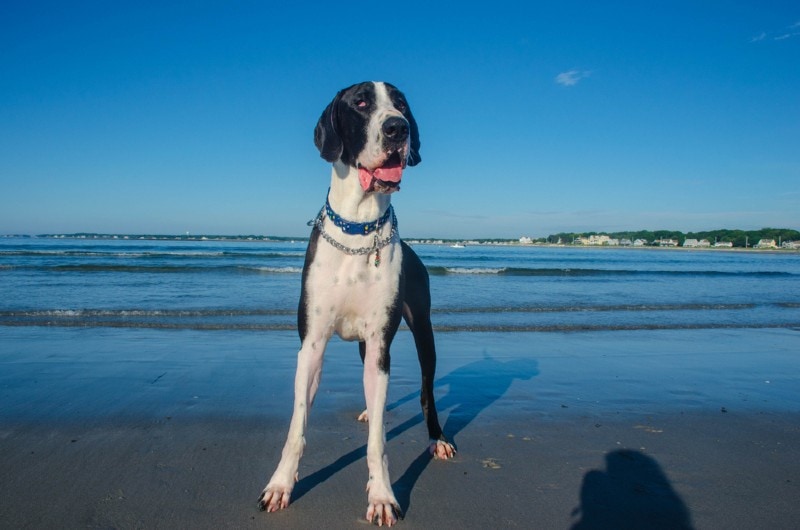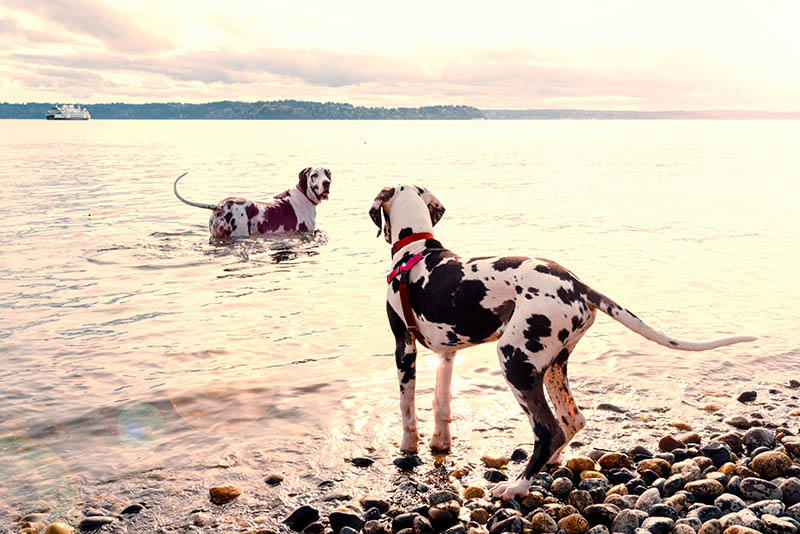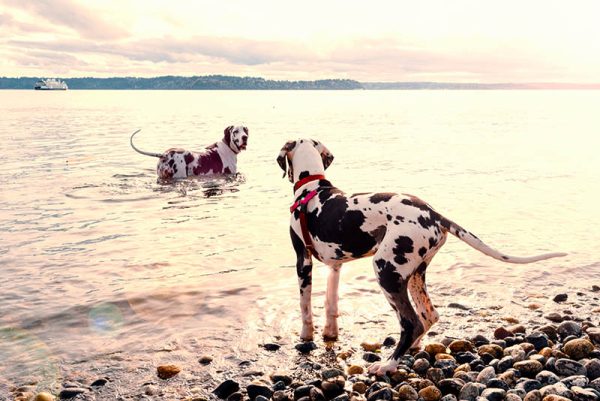Great Danes are one of the largest dogs in the canine world and can easily tower over any other breed of dog. A gentle giant, Great Danes are great family dogs. If you’re a family that enjoys going on trips or is constantly around water, you’re probably wondering if your Great Dane enjoys these water activities too. Do Great Danes like water?
As a breed, the Great Dane generally does not like the water, and would prefer to spectate, rather than get themselves wet. But as family dogs, they can eventually learn to like the water if made excited about it, or if constantly exposed to it—especially with their loved ones. They may even want to soak themselves if they see their family enjoying the water on a hot summer day!
Knowing that this large breed can learn to love water may also beget the question—can Great Danes swim?
What Were Great Danes Bred For?
Like most dog breeds back in the day, Great Danes were bred for a specific purpose. Great Danes were worker dogs bred for hunting. In the 16th century, Great Danes were used by hunters in Germany and Austria to bring down large animals, such as boars, bears, and deer. Their size and athleticism allowed them to serve as catch dogs, holding down the animals after they had been caught. Eventually, as advancements in hunting progressed, Great Danes were eventually bred to become the gentle, loving, and affectionate giants we know today.
Unlike other dogs bred for tasks involving water, Great Danes were generally not used anywhere near the water. In short, Great Danes were not built to become swimmers.
Can Great Danes Swim?

Although not designed to be swimmers, Great Danes can learn how to swim—and become good swimmers, at that!
If placed in a body of water, any dog will naturally try to keep their head above the surface and perform what is affectionately known as the doggy paddle. This behavior is instinctive in nature, even for dogs that are not natural swimmers.
Great Danes’ physical build also play a huge factor in their ability to learn how to swim, even though they are not natural born swimmers.
What Makes Great Danes Good Swimmers?
Great Danes can swim, not because they were designed to swim, but because of their physical build and strength. Great Danes’ gigantic build includes long, slender legs, a stocky, muscular chest, and a long neck and snout—all of which equip them to swim well.
Great Danes’ muscular upper body allows them to stay afloat, while also providing them with the energy to cruise and glide in the water while swimming. Their long legs also make paddling easier because of the increased surface-to-volume ratio during the paddle motion. Doggy paddling involves a similar motion to running on land—most of the work is performed by the front legs paddling, while the rear legs move in rhythm with a forward-backward motion.
Finally, Great Danes use their long neck and snout to keep their head above the surface while floating. This allows them to breathe much easier while treading in the water.
In addition to their physical traits, some Great Danes also have webbed paws. This was inherited from their hunting ancestors, as it gave them more traction when walking and running through muddy and snowy surfaces.

Can All Dogs Swim?
Many dogs can enjoy the water and splashing around it, especially if they’re exposed to it enough. All dogs can instinctively perform the doggy paddle, but that does not necessarily mean all dogs can swim. Certain breeds, such as Pugs, bulldogs, Basset Hounds, and even Dachshunds are unable to swim due to their short stature and stout legs that limit their ability to float and paddle.
Dogs with short necks and snouts, such as bulldogs, can also have trouble keeping their head up to breathe when in the water. Larger and heavier dogs also tend to sink rather than float.
How Do You Teach Your Great Dane to Swim?

If you want your Great Dane to learn how to swim, it is best to start exposing them to water as puppies. Like anything else with most dogs, training is much easier when done at a young age, compared to when they’re older.
Great Danes enjoy the company of their family, so seeing you having fun in the water will make them want to go in the water as well—which also give them a sense of security that the water is safe. When introducing water, it is best to start small with puddles, the bathtub, or the shallow end of the pool. Once comfortable, you can start gradually moving to the deeper and larger bodies of water as they gain their confidence.
It may take some time. Keep in mind that Great Danes are not natural swimmers. It is important to know your pet Dane to understand if they are ready or not. Remember that they are learning how to swim, it is not a natural-born skill they should be expected to have. So be patient and allow time for them to build their own confidence.
Know Your Dog’s Limits
It is important to note that not all dogs are the same. This also applies among Great Danes; they all have their own personalities and tolerance levels. As dog parents, we need to understand how they feel about the water. Some may be slower learners, some may tire much more easily, and some may just not like the water at all. Regardless, it is important to know your dog’s limits to prevent any injury.
Water Safety and Your Great Dane
Just like with children, don’t let your Great Dane swim unsupervised. You may be confident in their swimming skills, but it is still better to be prepared for unexpected accidents that may occur. While supervising, look out for signs of fatigue, panic, and distress, and be prepared to help them if need be. When watching your dog swim, it is important to be vigilant the same way you would be for your own kids!
Keep drinking water close as well. Swimming is a physically demanding activity. Your dog may end up feeling thirsty and require hydration, so it is best to be prepared. To prevent any illness, ensure your dog only swims in clean bodies of water.

Conclusion
As a breed, Great Danes do not typically like water, and they are not natural-born swimmers. But due to their love of spending time with family, along with their physical characteristics, Great Danes can adapt to the water.
Liking the water and swimming are both learned behaviors for Great Danes that stem from exposure and time spent with their loved ones. This means trips to the beach, the lake, or even the pool can be a very good bonding activity for your family, including your Great Dane!
You might also like:
Featured Image Credit: SeaRick1, Shutterstock










